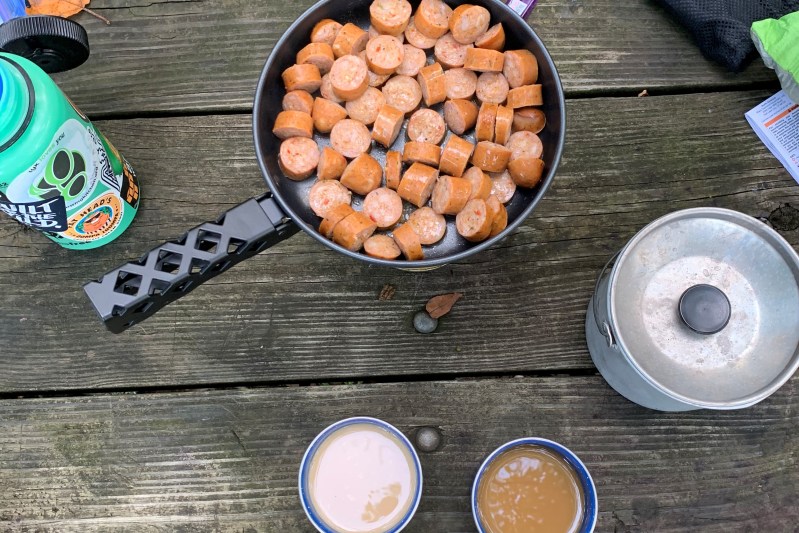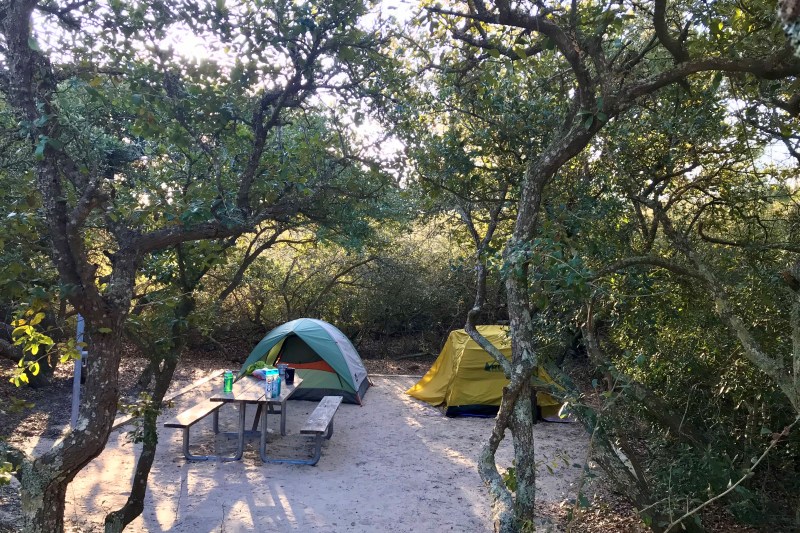Packing your life into a backpack and heading into the backcountry is one of the purest forms of adventure. Backpacking expeditions offer the opportunity to unplug from technology and unwind from the daily grind, all while admiring jaw-dropping natural wonders, having intimate encounters with wildlife, and seeking out epic stargazing spots. Making the leap to backpacking is a big step, even for seasoned car campers. When you’re ready to hit the backcountry, plan your first getaway with our beginner’s backpacking guide.
Choosing a Destination
While you hone your skills it’s good to stay within your comfort zone and choose a trip that doesn’t push your physical limits. Starting slow allows you to build confidence and work up to tackling more challenging routes. Consider your fitness level and navigational skills, along with external environmental factors like the difficulty of the terrain, seasonal temperatures, and potential for extreme weather. Start with a trail that’s easy to follow and save the bushwhacking for future trips, once you have mastered backcountry navigation.

What to Pack
When you have a few backpacking trips under your belt, you’ll have a good idea of the type of the best multipurpose gear that you like to use on the trail and whether you prefer to pack ultralight or carry a few more creature comforts. For your first few trips, we recommend following a checklist. These are seven essentials you’ll need for every backpacking trip:
- Tent or hammock. When choosing the best backpacking tent, be sure to consider seasonality, space, and weight. The standard 3-season tent can handle chilly temperatures in late spring or early fall but might falter in extreme conditions. If you are heading to higher elevations or a destination with the possibility of severe weather, it’s better to go with a sturdier 4-season tent to make sure you stay comfortable. On warmer trips, sleeping in a backpacking hammock can be a perfectly comfortable option, and an easy way to cut weight in your backpack.
- Sleeping bag and mat. When selecting the best sleeping bag, the first choice is between down or synthetic insulation. Bags insulated with down and are easy to compress and offer a better warmth-to-weight ratio than synthetic insulation. On the other hand, synthetic bags dry faster and typically cost less than down. Don’t forget to check the temperature rating to ensure your sleeping bag is warm enough for the nightly temperatures at your destination. Just like sleeping bags, there are plenty of options for backpacking and sleeping mats, too. Lightweight mats often have a lower R-rating — the scale used to show levels of insulation, a higher R-rating meaning more insulation — or come with an eye-watering price tag. Heavier duty mats usually offer more insulation on a budget, but remember that you have to carry everything you take.
- Headlamp. Unlike a traditional flashlight, a headlamp lets you be hands-free — especially useful for cooking after sunset, setting up camp in the twilight, or making late-night bathroom trips.
- Backpacking stove and fuel. The best backpacking stoves are lightweight and much more portable than what you might have used in the past for car camping. Make sure your fuel is compatible and don’t forget to bring a lighter, and a multi-tool or a pair of pliers to use as a pot grip for safely grabbing piping-hot cookware.
- Navigational Tools. While navigational apps like Gaia GPS, Hiking Project, PeakVisor, ViewRanger, and handheld GPS units are handy both for trip planning and finding your way on the trail, technology isn’t always reliable. Keep your map and compass handy and make sure you know how to navigate with both before heading into the backcountry.
- Dry Bags. A waterproof dry bag keeps your essentials dry in wet weather. You can stow your gear inside your dry bags in a series of dry bags and this makes it easier to find your gear at the end of the day, as well as keeping it dry throughout your trek.
- Trowel. A sturdy, plastic trowel is the best option for digging backcountry cat-holes when nature calls.

What to Wear
Your trail wardrobe will depend on the season and your intended destination, but it’s good to start with a few core pieces:
- Moisture-wicking base layers, like quick-drying t-shirts, or long underwear for colder climates.
- Functional layers for hiking, whether you prefer to hike in shorts or pants, go with gear that will dry quickly.
- A warmer layer, like a fleece or down jacket, along with a wooly hat and gloves.
- Rain gear. Be sure to pack both a waterproof jacket and pants. In a pinch, you can also don your rain gear for added warmth on chilly evenings, or protection from irksome insects.
- At least one pair of comfortable, moisture-wicking socks for the trail, and a spare pair for keeping your feet cozy at camp.
- Camp shoes. A spare pair of kicks — lightweight running shoes or sturdy sandals — give your feet a break at the end of the day.
Sustain Yourself
Running out of food or water can be disastrous, so take time to plan your meals carefully. Starting with the standard guideline that adults should consume 2,00o to 2,500 calories per day, consider the level of exertion required for your route. For starters, plan the breakfasts and dinners and for each of the days you plan to be out, and then supplement with calorie-dense snacks for the trail. Freeze-dried backpacking meals are convenient, and can reduce the amount of cookware you have to carry, but staples like pasta, rice, or oatmeal packed in ziplock bags work great on the trail too. To add a little flavor to your cuisine, dried herbs and spices are worth their weight in the backcountry.
Of course, water is just as important as food. Take stock of the water sources along your route, noting the number of opportunities to resupply — whether it’s a trailside spring, a mountain stream, or water-piping into a backcountry campground. In general, plan to carry at least two liters of water and to drink about a half-liter of water for every hour of hiking. To ensure your water is safe for drinking, be sure to bring a water filtering or purification system, or water-purifying drops or tablets.
Picking a Campsite

When selecting a camping spot, there are two main factors to consider — safety and sustainability. Before setting up your tent, check for natural features that could potentially be hazardous — dead trees could drop limbs, precarious ridgelines could be hard to navigate in the dark, and streams can flood in heavy rain or snowmelt. Think about reducing your impact on the wilderness by camping on a durable surface, like rock, sand, or gravel instead of more delicate vegetation.
Planning Ahead
Doing a little research on your route makes for a more seamless trip. Start by checking for any necessary permits or travel restrictions for your location, and then study the trail to identify any destination-specific challenges, like river-crossings or highly-exposed ridgeline traverses. Knowing a little background can also enrich your trail experience and help you keep an eye out for overlooked historic sites, obscure natural wonders, or rare wildlife.
Don’t forget to do a practice run to test your gear — even if it’s just in the backyard.
Being Ready for Emergencies
While taking a break from technology can be one of the highlights of time in the wilderness, in the case of an emergency, it’s good to have a lifeline. In the backcountry, cell phones aren’t always reliable. Instead, there are a variety of gadgets designed to keep you connected on the trail, including satellite messengers and personal locater beacons like the Garmin inReach Mini Satellite Communicator, the Spot X Satellite Messenger, or the .
And, even for short backpacking trips, a fully stocked first aid kit is essential. For starters, pack items like bandages for treating common wounds and injuries, medications, and ointments for common ailments like insect bites and stomach bugs, along with other essentials like tweezers, duct tape, and a heat-reflecting Mylar blanket. The National Park Service has a good list of basics. And, be sure to tailor your first aid kit to your specific destination — whether you are planning a few days in the desert, an alpine ascent, or a stint in a soggy boreal forest.
Respecting Wildlife

From bald eagles cruising serpentine rivers to elk bugling in the midst of the mating season, spotting wildlife along the trail is one of the highlights of any backpacking trip. But it’s important to give wild creatures a wide berth. Be aware of any critters that could pose a threat to humans — like venomous snakes, mountain lions, or moose. In the United States, one of the major animals to consider is the bear. Of the country’s three bear species, black bears are the most common — found in 40 states — while grizzly bears (a subspecies of brown bears), only live in a handful of states, including Alaska, Idaho, Montana, Washington, and Wyoming. When backpacking in bear country, it’s important to securely stash food, either in a hanging bag or a bear bin — and be sure you don’t cook near your tent. Overnight, store anything that smells like food — including toothpaste, soap, or deodorant — in a bear bin or hanging bear bag, to prevent curious bruins from visiting your tent. Consider carrying a can of bear spray as a precaution and brush up on what to do in the event of a wilderness encounter.
Minimizing Your Impact in the Wilderness
Whenever recreating outdoors, it’s important to minimize our impact on the natural world, and ensure these wild spaces can be enjoyed by other visitors. As a starting point, the Leave No Trace Center for Outdoor Ethics has developed seven basic principles for spending time outdoors, whether camping in the backcountry or just trail running a local park.



